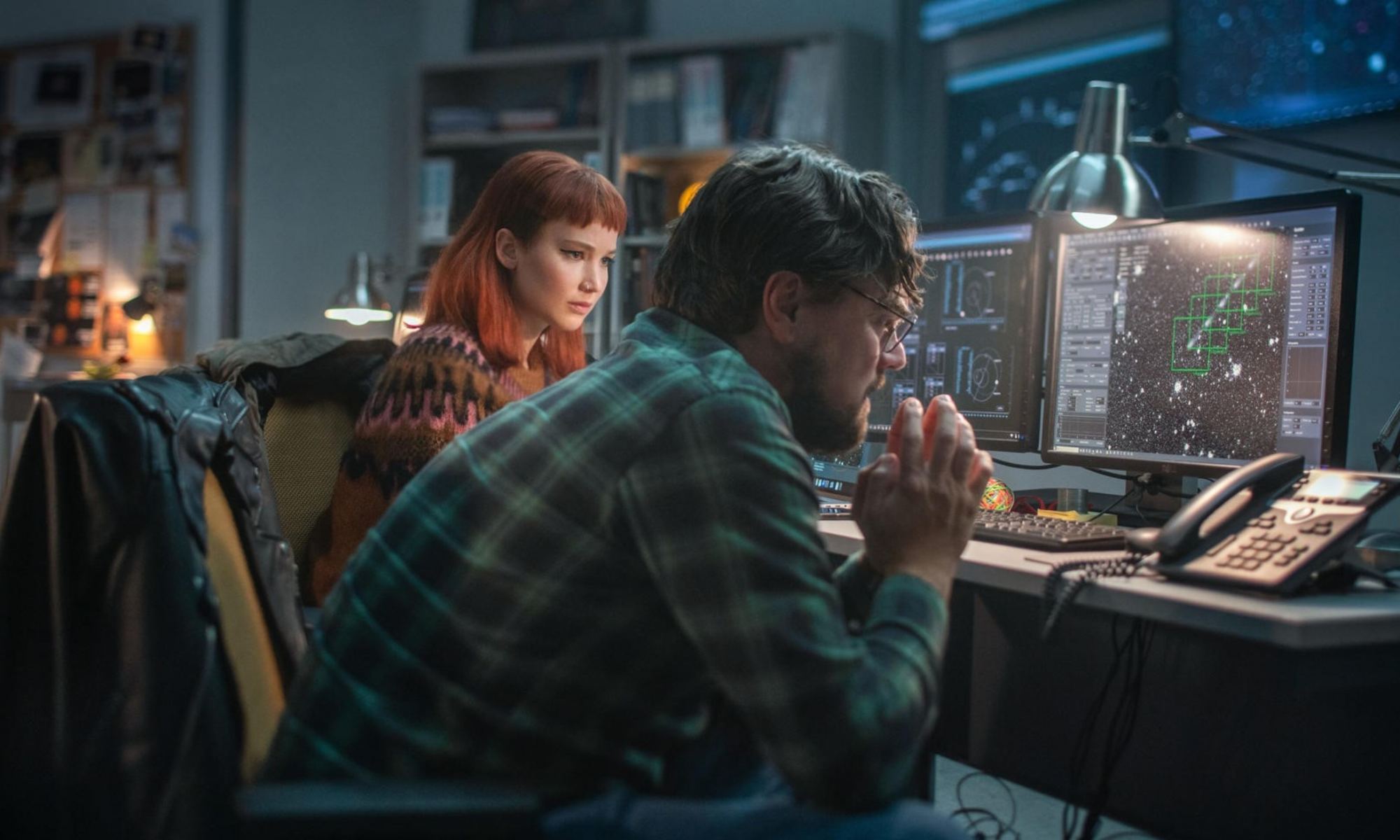The science adviser for “Don’t Look Up,” a star-studded comedy about a killer comet, has some serious advice for dodging a threat from the skies: Take the title of the movie, and do the exact opposite.
“The sensible thing to do about this particular problem is … just go look up and see if it’s out there,” said Amy Mainzer, a planetary scientist at the University of Arizona’s Lunar and Planetary Laboratory. “And do a thorough enough job of it that we have a reasonable chance of spotting something that’s large enough to cause appreciable damage, well before it could make its way here.”
The roughly 5-mile-wide comet that’s heading for Earth in “Don’t Look Up,” with only about six and a half months of advance warning, is totally fictional. Nevertheless, the movie is a teachable moment for the science surrounding asteroids, comets and planetary defense. And Mainzer said the stars of the show, including Leonardo DiCaprio and Jennifer Lawrence, were unusually eager students.
“These actors wanted to know everything,” she said. “I would say they’re approaching some pretty solid knowledge of just how do we find asteroids and comets, and what do we do about them.”
Mainzer discusses what’s going on with the search for potentially threatening near-Earth objects, as well as her experience as a science adviser for “Don’t Look Up,” in the latest episode of the Fiction Science podcast, coming to you from the place where science and technology intersect with fiction and popular culture.
You can listen to it via your favorite podcast channel — or right here:
“Don’t Look Up” isn’t just about the science of comets and asteroids: It’s also a wickedly funny parable about the entanglements between science and politics, media and money, especially when the stakes are high. It’s hard to avoid thinking about the climate crisis or the coronavirus pandemic as you watch the comet’s discoverers (played by DiCaprio and Lawrence) issue warnings that go unheeded.
No one thought more about that than film director Adam McKay, who says the movie was inspired by his concerns about climate change.
“There are so many subjects that have been turned political in this country that actually aren’t,” McKay says in the movie’s press notes. “Certainly a comet hitting the Earth should not be a political subject. The same way the climate crisis is just science. Same with a virus. It’s not really one side or the other.”
In “Don’t Look Up,” McKay turns a tale about Earth’s imminent doom into a satire about the politicization of scientific issues.
Meryl Streep plays a president with a sex-scandal past who starts wearing a cap with a polarizing slogan about the comet. Shakespearean actor Mark Rylance creates a portrayal of a socially awkward, space-savvy super-billionaire that manages to avoid coming too close to the persona of Jeff Bezos or Elon Musk. And Ariana Grande brings the glitz as a pop star who sings “Just Look Up,” a song that’s custom-written for a scene featuring a celebrity benefit concert.
Fortunately, the threat from potentially hazardous near-Earth objects isn’t a political issue, and it’s being taken seriously by policymakers as well as scientists. Just last month, NASA began a $330 million mission known as the Double Asteroid Redirection Test, or DART, to study what it would take to divert a threatening asteroid or comet.
NASA even has a Planetary Defense Coordination Office, which comes in for an on-screen shout-out in “Don’t Look Up.”
So far, astronomers haven’t identified a hazardous near-Earth object, or NEO, that has a significant chance of colliding with our planet in the foreseeable future. But based on past asteroid surveys, scientists say there are thousands of not-yet-observed objects big enough to wipe out an entire state if they were to hit just the wrong place.
Mainzer is the principal investigator for one of the surveys currently under way, known as NEOWISE, and she’s also heading up a mission called NEO Surveyor that’s due for launch in 2026. NEO Surveyor’s infrared telescope is optimized to detect and characterize near-Earth objects wider than 460 feet (140 meters) — which would include objects like the fictional comet in “Don’t Look Up.”
“The idea is not just to find them when they’re a few days away from impact, but to find them when they’re ideally decades away from impact, so that we have time to go out and build any mitigation missions that we might need,” Mainzer said.

There’s a host of other missions focusing on near-Earth objects, including Japan’s Hayabusa 2 mission, which sent back samples from asteroid Ryugu; and NASA’s OSIRIS-REx mission, which is bringing back bits from a different asteroid called Bennu.
By combining the insights gathered from survey missions like NEO Surveyor and sampling missions such as OSIRIS-REx, scientists and engineers expect to come up with a range of options for dealing with threatening asteroids and comets.
“If you don’t have a lot of time, probably the only thing you could do is try to move people out of the way,” Mainzer said. “But if you have more time, you can start to look at things like kinetic impactors, where you simply go and bump into the asteroid or the comet, and you try to bump it off course.”
Astronomers have also suggested more exotic strategies.
“There’s something called a gravity tractor, where the idea is, you just get a really big hunk of metal spacecraft and you park it next to the asteroid or comet, and you just wait. You let the faint pull of gravity do the work for you, pulling it off-course,” Mainzer said. “That takes time, though. It’s not something that you can do if you only have a little bit of warning. You need years to do that, ideally decades.”
The classic technique, at least judging by movies such as “Armageddon” and “Deep Impact,” involves blasting the thing off-course with nuclear bombs — preferably delivered by the likes of Bruce Willis (in the case of the asteroid from “Armageddon”) or Robert Duvall (who went after the comet from “Deep Impact”).
“Which technique you are able to choose depends heavily on how much time you have,” Mainzer said. “That’s the first key ingredient. So from my perspective, as an observer, my goal is to try to provide the time. … Otherwise, a lot of these options just simply aren’t available.”
There have been a few scares over the years, partly due to the uncertainty over the precise orbits of newly discovered near-Earth objects. The best example is the asteroid Apophis, which at one time was said to have a 2.7% chance of hitting Earth in 2029. That assessment was more of a reflection of observational uncertainty rather than the odds of an actual strike. Further observations made clear that Apophis posed no threat of a collision, at least for the next century.
In “Don’t Look Up,” policymakers and astronomers don’t always do a good job of explaining the science, due to bad intent or just bad communication skills. And Mainzer said that’s another important message she wanted the movie to get across.
“We don’t always get everything perfectly right, but we do try,” she said. “It’s also just a commentary on how we make science-based decisions as a society or not. … As a scientist, I want to provide the best information that I can to everybody else. And I hope that people use that information to make their decisions about what to do next.”
If Mainzer has succeeded in her mission, the folks who see “Don’t Look Up” will know a lot more about the science of asteroids and comets by the time the credits roll. (And you will want to watch all the way past the credits for a stinger scene.)
“I do enjoy this movie quite a bit, and I hope other people will, too. This one is my current epic disaster-movie favorite, and that is honestly how I feel about it,” she said. “It will make you laugh, and might make you think — but hopefully it’ll be good.”
“Don’t Look Up” goes into theatrical release on Dec. 10, and it will be available via Netflix starting Dec. 24.
This report was originally published on Cosmic Log. The Fiction Science podcast is co-hosted by Alan Boyle and Dominica Phetteplace, an award-winning writer who is a graduate of the Clarion West Writers Workshop and currently lives in Berkeley, Calif. To learn more about Phetteplace, check out her website, DominicaPhetteplace.com.
Stay tuned for future episodes of the Fiction Science podcast via Anchor, Apple, Google, Overcast, Spotify, Breaker, Pocket Casts, Radio Public and Reason. If you like Fiction Science, please rate the podcast and subscribe to get alerts for future episodes.
Lead image: Jennifer Lawrence and Leonardo DiCaprio portray scientists who find a killer comet in “Don’t Look Up.” Credit: Netflix / Niko Tavernise

